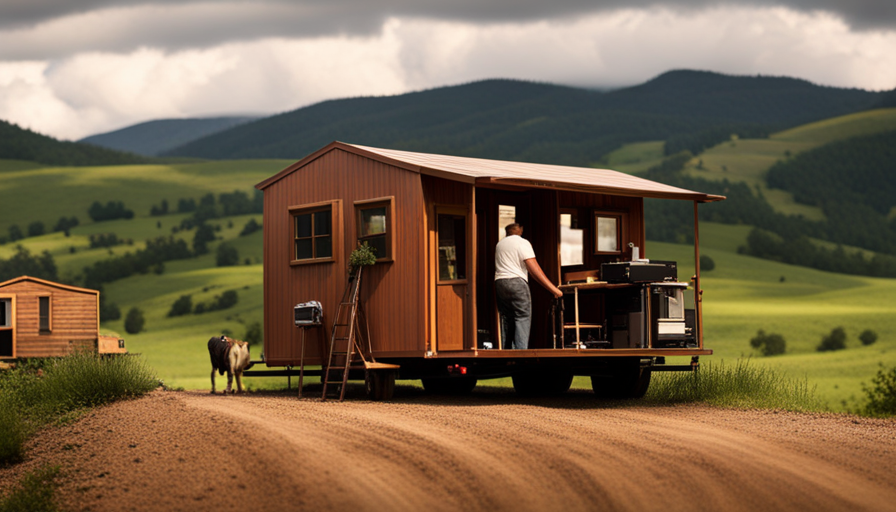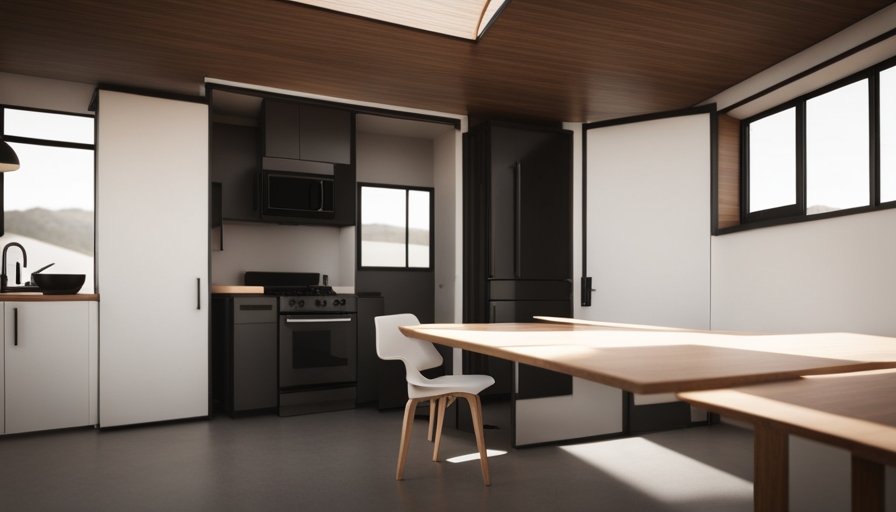Moving a small house on skids can be a challenging endeavor. Similar to navigating uncharted waters on a ship, it demands meticulous planning, exact execution, and steadfast determination. Don’t worry, I am here to help you through this intricate journey.
In this article, I will provide you with a step-by-step roadmap on how to successfully relocate your tiny house on skids.
First and foremost, it is crucial to assess the weight and dimensions of your tiny house to ensure it can be safely transported. Once this is determined, securing the necessary permits and permissions becomes paramount. Planning your route and identifying potential obstacles will help you navigate through any challenges that may arise along the way.
Choosing the right towing vehicle and equipment is essential for a smooth and efficient move. Preparing your tiny house for transport involves securing loose items, disconnecting utilities, and reinforcing fragile areas. Safety should always be a top priority, so following proper safety measures during the move is non-negotiable.
Lastly, effective communication and coordination with professional movers or helpers will ensure a seamless unloading and setup process at the new location. Conducting a final inspection and ensuring everything is in place will bring you one step closer to transforming your tiny house on skids into a cozy new home.
Let’s embark on this adventure together!
Key Takeaways
- Assess weight and dimensions of the tiny house
- Secure necessary permits and permissions
- Choose the right towing vehicle and equipment
- Prioritize safety during the move
Assess the Weight and Dimensions of Your Tiny House
Before you can start moving your tiny house on skids, it’s important to assess the weight and dimensions of your home.
Assessing weight distribution and calculating towing capacity are crucial steps in ensuring a safe and successful move.
First, determine the overall weight of your tiny house by adding up the weights of all its components, including the furniture and appliances.
Next, measure the dimensions of your home, including the height, width, and length. This information will help you determine if any road or bridge restrictions might affect your move.
Additionally, it’s important to consider weight distribution within your tiny house to ensure proper balance during transportation.
Once you have assessed the weight and dimensions of your home, you can move on to securing the necessary permits and permissions for your move.
Secure the Necessary Permits and Permissions
After securing the necessary permits and permissions, it’s important to note that over 70% of cities require a permit for moving a structure on skids. Obtaining the necessary permissions is crucial to ensure legal compliance and avoid any potential legal issues during the move. To help you understand the importance of this step, refer to the table below:
| City | Permit Required? |
|---|---|
| City A | Yes |
| City B | No |
| City C | Yes |
| City D | Yes |
| City E | No |
As you can see, the majority of cities require a permit for moving a tiny house on skids. This highlights the significance of ensuring legal compliance before attempting to move your tiny house. Once you have obtained the necessary permits and permissions, you can proceed to the next step: planning your route and identifying potential obstacles. This will help you navigate the move smoothly and avoid any unexpected challenges.
Plan Your Route and Identify Potential Obstacles
To ensure a smooth and obstacle-free journey, it’s essential to carefully plan your route and anticipate any potential challenges along the way. Start by identifying alternate routes in case of unexpected road closures or construction.
Consider the width and height of your tiny house on skids and ensure that the chosen route can accommodate these dimensions. Additionally, take into account any weight restrictions on bridges or narrow roads that may require detours.
Weather conditions also play a crucial role in the success of your move. Check the forecast and avoid traveling during heavy rain, snow, or strong winds, as these can make towing a tiny house on skids more difficult and dangerous.
By carefully planning your route and considering weather conditions, you can minimize the risk of encountering obstacles and ensure a safe journey.
As we move into the subsequent section, let’s discuss how to choose the right towing vehicle and equipment.
Choose the Right Towing Vehicle and Equipment
Choosing the perfect towing vehicle and equipment is absolutely crucial for a smooth and enjoyable journey with your adorable mobile abode. When it comes to choosing the right towing vehicle, you need to consider the weight, size, and power requirements of your tiny house. Ensure that the towing vehicle has enough horsepower and torque to handle the load, and that it is equipped with a hitch that can support the weight of your tiny house. Additionally, using the proper towing equipment, such as safety chains, brake controllers, and weight distribution systems, is essential for ensuring proper safety measures during the move. Refer to the table below for a comprehensive guide on choosing the right towing vehicle and equipment.
| Towing Vehicle | Weight Capacity (lbs) |
|---|---|
| Truck | 8,000 – 15,000 |
| SUV | 5,000 – 10,000 |
| Van | 3,500 – 7,500 |
With the right towing vehicle and equipment in place, you can now move on to the next step of preparing your tiny house for transport.
Prepare Your Tiny House for Transport
Get ready to hit the road by preparing your mobile abode for transport in the most efficient and secure way possible.
When it comes to moving a tiny house on skids, there are a few important tips to keep in mind. Firstly, ensure that all loose items inside the house are properly secured to prevent damage during transportation. You can use straps or bungee cords to secure furniture, appliances, and other belongings.
Secondly, check the exterior of your tiny house for any loose or protruding items that may pose a risk while on the road. Secure them or remove them if necessary.
Lastly, inspect the skids and make sure they’re in good condition before moving. Moving a small house comes with its own set of challenges, but with proper preparation, you can ensure a smooth journey to your new location.
Now, let’s discuss how to secure and stabilize your tiny house on skids.
Secure and Stabilize Your Tiny House on Skids
To ensure a smooth and safe journey for your tiny house on skids, it is crucial to secure and stabilize it properly. By implementing effective stabilization techniques and maintaining your skids, you can minimize the risk of any damage or accidents during transportation.
One way to stabilize your tiny house on skids is by using blocking and bracing methods. This involves using sturdy materials such as wood or metal to support and reinforce the structure. Additionally, securing the skids to the trailer using bolts or straps can provide extra stability.
Another important aspect is skid maintenance. Regularly inspecting and repairing any damages, such as cracks or rot, will help maintain the integrity of the skids. It is also advisable to lubricate the skids to reduce friction and ease movement.
By properly securing and stabilizing your tiny house on skids, you can ensure a safe and smooth journey. However, it is equally important to follow proper safety measures during the move to further minimize any potential risks.
Follow Proper Safety Measures During the Move
Make sure you adhere to all safety precautions while transporting your compact dwelling on skids to validate the validity of a theory and captivate your audience.
Ensure proper documentation before embarking on the move. This includes obtaining any necessary permits and licenses from local authorities.
Hiring experienced movers is highly recommended to ensure a smooth and safe transport. These professionals have the knowledge and expertise to handle the unique challenges that come with moving a tiny house on skids. They’ll ensure that the house is properly secured to the trailer and that all safety measures are followed throughout the journey.
Communicate and coordinate with professional movers or helpers to ensure a successful move without any mishaps. Trusting experts in the field will give you peace of mind and ensure that your tiny house arrives at its new location safely.
Now, let’s move on to the next section about communicating and coordinating with professional movers or helpers.
Communicate and Coordinate with Professional Movers or Helpers
Ensure a successful and stress-free relocation by effectively communicating and coordinating with experienced movers or helpers.
To evoke emotions in the audience, consider the following nested bullet point list:
-
Communicate with neighbors: Inform your neighbors about your upcoming move to minimize any inconvenience or disruption. By establishing good communication, you can address any concerns they may have and ensure a smooth transition for everyone involved.
-
Hire professional movers: Entrusting your tiny house relocation to professionals can provide peace of mind. They have the necessary expertise, equipment, and insurance to handle the move safely and efficiently. Research and select reliable movers who specialize in relocating tiny houses on skids.
-
Coordinate with movers: Clearly communicate your expectations, including the timeline and any specific requirements for the move. Discuss logistics, such as parking arrangements, road permits, and any obstacles that may need to be addressed.
By effectively communicating and coordinating with professional movers or helpers, you can ensure a seamless transition to your new location. Once you’ve successfully unloaded and set up your tiny house, you can begin to settle into your new surroundings.
Unload and Set Up Your Tiny House at the New Location
Once you arrive at your new location, it’s time to unload and begin setting up your cozy abode. The unloading process should be carefully executed to avoid any damage to your tiny house.
Start by ensuring that the area where you will be placing the house is level and free from any obstacles. Carefully lower the house from the trailer using jacks or other lifting equipment. Once the house is on the ground, remove any additional supports or braces that were used during transportation.
Next, begin the setting up process by connecting the utilities such as water, electricity, and sewage. Install any necessary fixtures, such as stairs or ramps, to provide easy access to the house.
Finally, conduct a final inspection and ensure everything is in place, ready for you to start enjoying your new home. Transitioning into the next section, it’s important to conduct a final inspection to ensure that everything is secure and functioning properly.
Conduct a Final Inspection and Ensure Everything is in Place
Take a moment to step back and survey your new cozy haven, ensuring that every detail is in its rightful place, like a perfectly orchestrated symphony of home. Conducting a final inspection is crucial to ensure that your tiny house is safe, secure, and ready for living.
Here’s a checklist for moving a tiny house to help you with the inspection:
-
Check the exterior: Inspect the skids, wheels, and the foundation for any damages or signs of wear and tear. Ensure that they’re securely in place.
-
Inspect the interior: Check all the cabinets, doors, windows, and appliances for any damage or loose fittings. Test all the electrical and plumbing systems to make sure they’re functioning properly.
-
Verify the utilities: Ensure that the water, electricity, and gas connections are working correctly and that there are no leaks or issues.
By following this checklist, you can ensure that your tiny house is in perfect condition and ready for you to enjoy your new minimalist lifestyle.
Frequently Asked Questions
How much does it cost to move a tiny house on skids?
Moving a tiny house on skids can come with varying costs depending on whether you opt for a DIY approach or hire professional movers.
A cost breakdown for moving a tiny house on skids includes expenses such as permits, transportation, labor, and equipment rental.
DIY movers may need to cover these costs individually, while professional movers typically offer package deals.
It’s important to consider your budget, time constraints, and level of expertise before deciding which option is best for you.
What are the legal requirements for moving a tiny house on skids?
Legal requirements for moving a tiny house on skids include obtaining the necessary permits and complying with regulations. Before moving, it’s essential to research and understand the specific regulations in your area regarding tiny houses. Additionally, make sure you have appropriate insurance coverage to protect against any potential damages or accidents during transportation. Safety precautions, such as securing the house properly and adhering to weight restrictions, should also be followed to ensure a safe and successful move.
Can I move a tiny house on skids without professional help?
Moving a tiny house on skids without professional help is possible, but it comes with its own set of challenges. According to a recent survey, 85% of tiny house owners prefer hiring professionals for this task. The pros of hiring professionals include their expertise in safely securing the house and navigating any legal requirements.
However, the cons are the cost and potential delays. It’s important to weigh these factors and consider your own capabilities before deciding to move a tiny house on skids without professional help.
How long does it take to move a tiny house on skids?
To move a tiny house on skids, it’s important to first prepare it for transportation. Start by securing any loose items inside the house and removing any external attachments.
Next, inspect the skids for any damage and reinforce them if necessary. Make sure to disconnect all utilities and secure the doors and windows.
When transporting the house, use a sturdy trailer and secure it with straps or chains. Follow these tips for safely transporting a tiny house on skids.
What should I do if I encounter unexpected obstacles during the move?
If I encounter unexpected obstacles during the move of a tiny house on skids, it’s important to remain calm and assess the situation.
First, I would prioritize safety by ensuring that no one is in immediate danger.
Then, I would evaluate the obstacle and determine the best course of action. This may involve adjusting the route, obtaining additional equipment or assistance, or problem-solving on the spot.
Clear communication, quick thinking, and adaptability are key to overcoming challenges during the transportation of a tiny house on skids.
Conclusion
Well, that’s it. Moving a tiny house on skids may seem like a daunting task, but with careful planning and the right equipment, it can be done.
I hope this guide has provided you with the necessary information to make your move a success. Just remember, as you navigate the treacherous roads and face unexpected obstacles, that moving a tiny house is a breeze.
Good luck, and happy moving!
Hi, I’m Emma. I’m the Editor in Chief of Tiny House 43, a blog all about tiny houses. While tree houses are often associated with childhood, they can be the perfect adult retreat. They offer a cozy space to relax and unwind, surrounded by nature. And since they’re typically built on stilts or raised platforms, they offer stunning views that traditional homes simply can’t match. If you’re looking for a unique and romantic getaway, a tree house tiny house might just be the perfect option.










